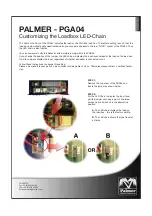
2.9
Cleaning a vehicle
1. Wear protective clothing, gloves and goggles when
you clean the bodywork of an Olympus Mini refuse
collection body. Loose debris may be ejected from
the body and tailgate.
2. Never enter the body or tailgate unless the
‘Body main’ key operated switch is in the OFF
position with the key removed (see Olympus
Mini Operator’s Handbook, Chapter 4 Operator’s
Controls), the engine is stopped, the ignition key
is removed, all cab doors are locked with the
keys removed and you are in possession of all the
removed keys, and any spare keys.
3. Be aware of dangerous refuse such as glass and
hypodermic needles.
4. Do not climb into the tailgate to clean debris
unless you know and can work to the safe working
procedures given in this manual.
5. Never clean the seal area between the tailgate and
body unless the tailgate is fully propped.
6. Make sure that all body and tailgate drains are
closed and that their operating levers are not
protruding from the side of the vehicle when
cleaning is completed.
2.9.1
Pressure washing
wARNING:
dO NOT dIReCT PReSSuRe wASHeR AT
A PeRSON. HIGH-PReSSuRe wATeR JeTS
CAN CAuSe INJuRY.
Caution:
High-pressure water jets can cause severe
damage to electrical equipment.
1. When pressure washing do not allow the jet nozzle
to approach closer than 1 metre.
2. Whenever possible do not direct the jet straight at
components, but aim across them.
3. Do not direct the jet at electrical components.
2.10
Vehicle electrical systems
2.10.1
General electrical precautions
1. Always ensure correct polarity when making cable
connections.
2. Before using any test equipment always read the
manufacturer’s instructions.
3. Do not pierce any electrical leads or looms with
test probes, etc.
4. Ensure that no arcing takes place between
electrical connections.
5. Always ensure that electrical components, wiring
looms and harnesses are correctly fitted and
connected. Incorrect fitting, incorrect connections,
additions or alterations to an electrical system
could create a risk of injury and fire.
6. Always remove all personal jewellery, e.g. rings,
watches, chains etc., before commencing work
on the electrical system even if the battery is
disconnected.
7. Never guess the polarity of connections or wiring,
use a voltmeter and refer to circuit diagrams.
8. Use good quality electrical test meters when
carrying out tests. A poor meter can affect the
results you obtain and may damage electronic
components.
9. Only use slave battery sets incorporating an
isolator switch to start the vehicle.
10. Only use batteries with a combined total voltage
of 24 V, or a vehicle with a 24 V electrical system.
Failure to do so will result in extensive damage to
the equipment.
HeALTH ANd SAFeTY
2‑12
OM1R-SM-GB01R
2
Summary of Contents for Olympus Mini
Page 2: ......
Page 6: ...Contents iv OM1R SM GB01R This page intentionally left blank ...
Page 8: ...Introduction 1 2 OM1R SM GB01R This page intentionally left blank 1 ...
Page 10: ...Introduction 1 4 OM1R SM GB01R This page intentionally left blank 1 ...
Page 12: ...Health and safety 2 2 OM1R SM GB01R This page intentionally left blank 2 ...
Page 26: ...Daily checks 3 2 OM1R SM GB01R This page intentionally left blank 3 ...
Page 56: ...Hydraulic system oil level 4 2 OM1R SM GB01R This page intentionally left blank 4 ...
Page 64: ...Cleaning 5 2 OM1R SM GB01R This page intentionally left blank 5 ...
Page 70: ...Scheduled maintenance 6 2 OM1R SM GB01R This page intentionally left blank 6 ...
Page 98: ...General specification data 8 2 OM1R SM GB01R This page intentionally left blank 8 ...
Page 102: ...General specification data 8 6 OM1R SM GB01R This page intentionally left blank 8 ...
















































